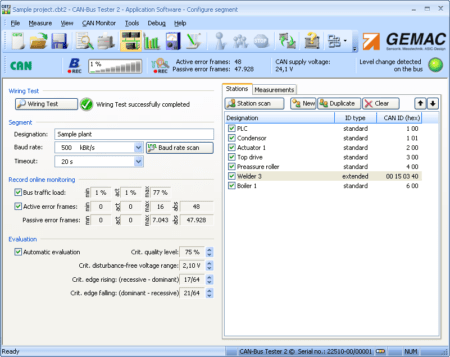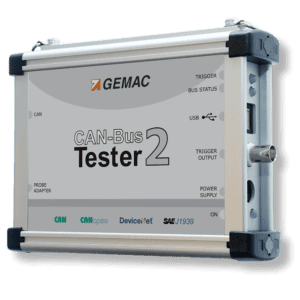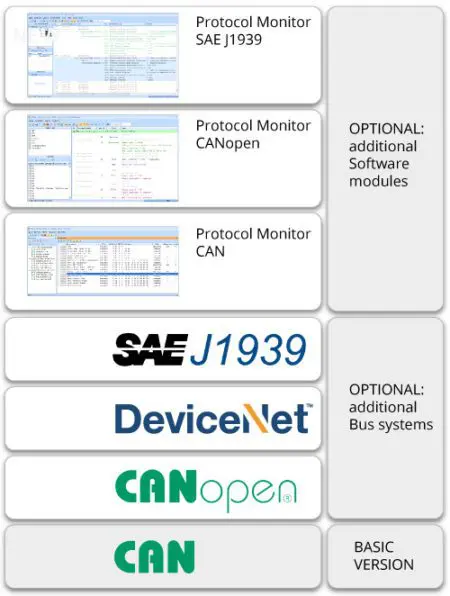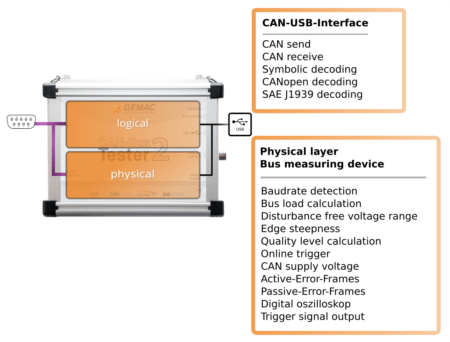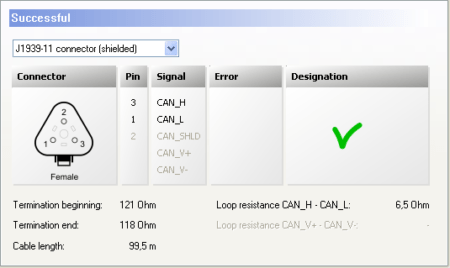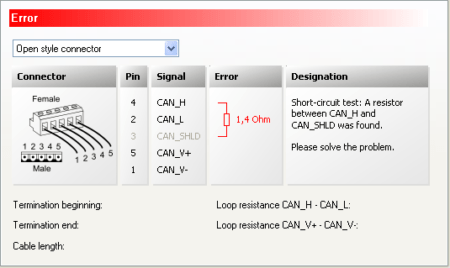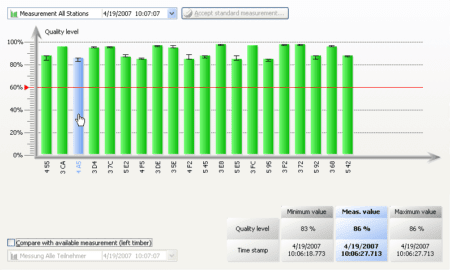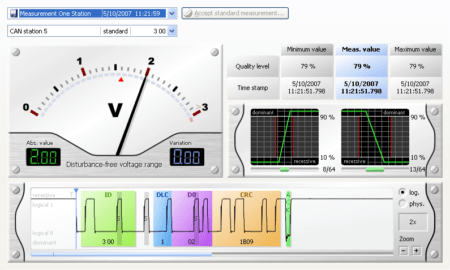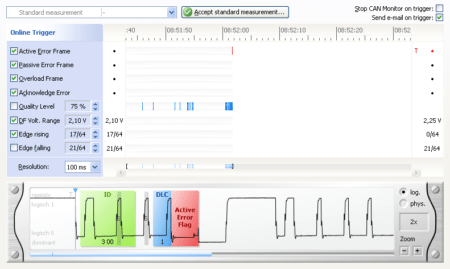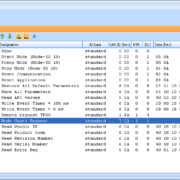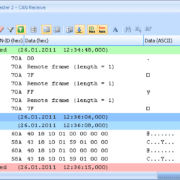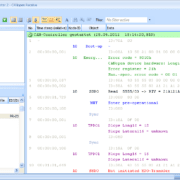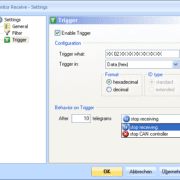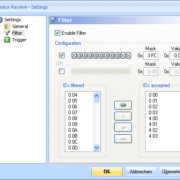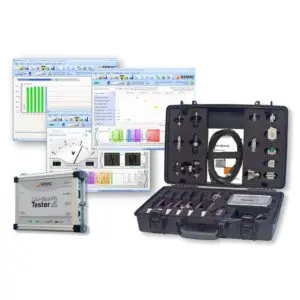通用測量儀器用以調試、分析、監測、故障排除和維修/保養 CAN-Bus
Possibilities
The CAN-Bus Tester 2 is a widely used measuring device for control of bus parameters. The success story starts already in the year 2002 with the first model. The hardware was completely redesigned in version 2. The corresponding software is still developed and has been enhanced with extensive updates.
Check the setup of the bus before you switch on with the bus wiring test, measure under running conditions down on the physical layer and analyses data of the nodes with the protocol monitor. The longtime monitor shows scattered errors and creeping signal loss.
The trigger output makes it possible to show data from only one node of the bus.
The great box contents within the service case with big adapter set make it possible to use the device out of the box in many environments. You can save your measurements and print a status protocol directly from the software.
Bus Systems
The measuring device works in the networks CAN, CANopen, DeviceNet and SAE J1939.
The CBT2 can also be used for measurements in other bus systems based on the CAN standard. These include Isobus, NMEA 2000 and SafetyBus P, but also Energy bus, CANaerospace and ARINC825. Niche bus systems are MilCAN and CANopen Lift.
License Model
In the basic configuration, the CAN-Bus Tester 2 is enabled for bus system CAN. You can do all physical measurements within this system.
Additional licenses are offered to the systems CANopen, DeviceNet and SAE J1939. With them, it is much easier to assign the messages to the real nodes.
The optional protocol monitor is for logical bus analysis in the bus systems CAN (transmit/receive), CANopen (receive) and SAE J1939 (receive).
The user software is free to download and use, only for measurements with the CAN-Bus Tester 2 it has to be unlocked.
Connections
Power Supply
The device works with 9 – 36 V. Only for the Bus Wiring test min. 24 V is needed.
USB Port
Connect your Windows PC or laptop here.
CAN and CAN probe port
Two 9‑pin D‑Sub ports are for connection to the bus and for probes
Trigger Output
For further measurements with a digital storage oscilloscope, the CAN-Bus Tester 2 can be used as the trigger source.
Two Devices in one
The CAN-Bus Tester 2 is basically a 2‑in‑1 device. One part is responsible for the extensive measurements on the physical level. The 64-fold sampling of each individual bit makes detailed evaluation possible.
The other part is a CAN-to-USB interface for comprehensive protocol analysis. Both parts of the device can work independently of each other or simultaneously and together.
Among many other things, it is possible to stop the protocol analysis automatically if the physical measuring device has detected a problem. In this way, the data traffic can be evaluated immediately before an error occurs. You don’t have to search through long lists of telegrams, the end of the list is the relevant point.
Bus Wiring Test
With the wiring test, it is possible to determine line short-circuits, line breaks, the bus termination, the loop resistance of the CAN line and the CAN power supply line and the overall line length.
To ensure correct bus cabling, it is recommended to perform the wiring test at the beginning of any plant measurements.
Node Measurement
Connect the CAN-Bus Tester 2 to your bus line. You should see a green led on your display, showing that there is data traffic.
First, start the baud rate scan, then scan for nodes. All messages on the bus are now received and analyzed, the nodes with their ID are listed. Name the nodes if you want for a better overview.
With the measurement “all stations view” you get an overview of the quality levels of the signals. The bar diagram makes it easy to compare. At continuous mode, you will additionally see the min/max values. You can easily compare to a saved measurement.
The measurement “one station’s view” shows the single values of one node and shows a physical and logical decoded oscillogram. Quality level, edge steepness and disturbance-free voltage range are the three showed measurands. By starting a continuous measurement you will also see the min/max of quality level and the variation of the disturbance-free voltage range.
Online Monitor
This measurement runs continuously and compares with given thresholds. If it overruns the threshold the error will be registered. In the single measurement mode, it stops and the faulty message is showed in the oscilloscope view. In continuous mode, the error is marked in a timing diagram. So you show when your threshold was overruled or if an error frame has occurred.
The observed values are
- Active-Error /Passive-Error Frames
- Overload Frames
- Acknowledge Error
- General quality level (0 … 100 %)
- Disturbance-free voltage range (minimum noise-free differential voltage)
- Edge steepness (worst rising and falling edge of a message)
Additionally, to this logical and physical measurements, the CAN-Bus Tester 2 is continuously determining bus traffic load, bus status and the optional CAN supply voltage.
The software can be adjusted in a way, that a simultaneously running Receive in the protocol monitor is stopped in case of an error. So it is easier to analyze that data traffic that was on the bus before the error occurred.
Protocol Monitor
Many features of the CANvision Protocol Monitor are built in the CAN-Bus Tester 2 user software. It is easily unlocked when you buy a license.
Inform yourself about the range of features of CANvison here.
The main difference is the network capability, this can only be used with the full version of CANvision.
Technical Data
-
• General parameters and overview of functionsBus systems
CAN (ISO11898‑2), CANopen (CiA301), DeviceNet (EN 50325 – 2), SAE J1939
Bit sampling
64-fold, 10,240 sampling points
Bit timing
Adjustable BTL cycles (tq), sample point and resynchronization jump width (SJW)
Supported baud rates
Depending on bus system: 10; 20; 50; 100; 125; 250; 500; 800; 1000 kbit/s
Additionally user-defined: 5; 33.3; 62.5; 75; 83.3; 200 kbit/s
Automatic detection via baud rate scanList of stations
Automatic detection via Station scan
Designation, CAN ID, ID type, Node ID, MAC ID, Source address,
can also be entered manuallyList of Measurements
Possibility to measure at different measuring points and at different times
Sorting by measurement type, measuring point and measurement timeQuality level
Value representing the signal quality (0 …100%)
The minimum value and maximum values
saved timestampDisturbance-free voltage range
and edgesDisturbance-free voltage range (typ. ‑0.75 … 3 V, resolution 50 mV)
Edge steepness (falling and rising, specified in 1/64th of the bit width)
The minimum value and maximum values savedOscilloscope display
Trigger on message frames with the specified ID, trigger position can be set
Frame analysis and full frame recording
Decoding according to the protocol (CAN, CANopen, DeviceNet, SAE J1939)
Zoom (six stages)Online Trigger
Real-time monitoring of the bus for logical and physical errors
Resolution can be set (10 ms … 1 min)
Oscilloscope display and e‑mail notification on triggersAutomatic evaluation
Limit value settings and measured-value evaluation according to:
• critical quality level
• critical disturbance-free voltage range
• critical edge (rising and falling)Bus status
Bus traffic detection (display: dominant, recessive, not defined, bus traffic)
Bus traffic load
Permanent display of the bus traffic load (0 … 100%),
Minimum and maximum values savedError frames
Constant display of detected frame errors
Distinction between active and passive error frames (0 … >50,000)Protocol monitor
CAN: Reception of CAN message frames incl. filtering, Transmission of CAN
message frames and sequences (message lists)
CANopen: Interpretation of all CAN messages according to the CANopen spec as SDOs, PDOs, NMT‑, Heartbeat‑, Emergency‑, Sync- and Timestamp
(CiA301, CiA302, CiA305, CiA401, CiA402, CiA404, CiA406, CiA408, CiA410, upgradeable)Test record
Comprehensive, configurable measuring and test record on DIN A4:
• Letterhead with tester and customer contact data
• The tabular representation of the measured values
• Graphic representation of the measured valuesExport function
Measuring data as a configurable CSV file
Graphical measured-data representation as a configurable bitmap (.bmp,.jpg,.png)Firmware and FPGA configuration
can be updated via USB
• Electrical parameters
Power supply
Via the supplied wide-range power supply (9 … 36 V DC)
Current consumption
0.55 … 0.15 A
Measuring of the differential voltage
typ. ‑0.75 V … 3.00 V
Measuring of the loop resistances
typ. 0 Ω … 800 Ω
Measuring of the cable length
typ. 0 m … 500 m
• 0…100 m: Resolution: 0.5 m, Accuracy: 3 % ± 1.5 m
• 100…500 m: Resolution: 1.0 m, Accuracy: 10 % ± 10 m
for a signal runtime of: 4.5 ns/m for CAN/CANopen/SAE J1939, 4.3 ns/m for DeviceNet
Measuring of the CAN supply voltage
0 … 36 V
Potential difference between the connections CAN bus, USB and oscilloscope
< 50 V DC (or < 71 V AC)
Trigger output for the oscilloscope
BNC socket, electrically isolated, H pulse, approx. 2 bits wide, level approx. 5 V
• Mechanical parameters
Supply voltage connection
Extra-low voltage socket
CAN connection
2 x 9‑pin D‑Sub connector
PC connection
Self-powered device to USB Specification 1.1, electrically isolated
Trigger output for oscilloscope
BNC socket, electrically isolated
Housing
Aluminum sheet housing
Temperature range
Operation: 5 °C … 40 °C
Storage: ‑20 °C … 60 °CHumidity
Operation: 20 % … 80 % (non-condensing)
Storage: 20 % … 80 % (non-condensing)Degree of protection of the housing
IP20 to EN 60529
Dimensions (Device /Case)
170 mm x 134 mm x 40 mm /504 mm x 354 mm x 119 mm
Weight (Device /Case)
Approx. 600 g /Approx. 5000 g
Warning:
The CBT2 is a Class A device. Such devices can cause interference in residential areas. In this case, the plant operator can be required to take appropriate measures and to bear the costs of such measures.
